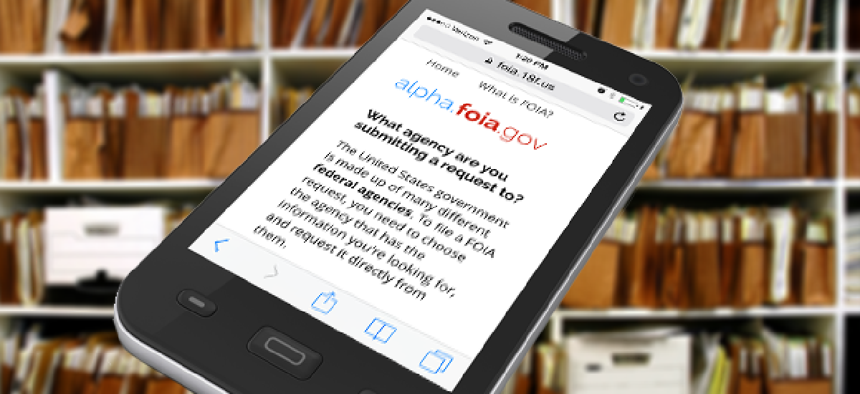FOIA hub aims to traffic frequent requests


Connecting state and local government leaders
A consolidated, open source site built by the government’s digital services group sends users to agencies’ FOIA landing pages and common FOIA requests.
The task of fulfilling Freedom of Information Act requests has dogged requestors and the government workers who respond to them since the law was passed in 1966. But a new site under construction could help make the process easier for requesters and lighten the load for government.
Announced in September, the alpha foia.gov is an open source site built by 18F, the digital services group within the General Services Administration charged with helping agencies meet their mission by developing digital and web services.
Although it’s still very much in the early phases, a prototype of the request process demonstrates how the process will work:
The simple mobile site features a home page with a search box for public records and a blog post. The request page asks users to enter an agency name or choose from a supplied list, which takes them to a page with the agency’s FOIA information and access to a FOIA request form.
Agencies have been working to such information available to the public by making frequently requested documents easy to find.
But a new idea, floated by the Proactive Disclosure Subcommittee of the FOIA Advisory Committee, suggests that FOIA requests not only often center around clusters of categories but also that frequent and active requesters themselves fit into types – journalists, government watchdog groups, plaintiffs attorneys, etc.
If requested data were machine readable – like the disclosure of payment information under the Data Act’s transparency rules – frequent requesters could be identified and their needs proactively met. Such categorization could save FOIA offices time and money fulfilling requests and improve agency compliance.
However, the subcommittee sees challenges in breaking down agencies’ FOIA requests by record type, request type, or requester type and in obtaining FOIA logs with descriptions detailed enough to get the data needed for analysis.
The team at 18F is looking to build tools that will improve the request submission experience, create a scalable infrastructure for requests and make it easier for people to find information that’s already publicly available, according to a post by the team on the 18fblog.
“Currently, we’re coding our own open source technology from scratch,” said Raphael Majma from the 18F project team. “What features get included in that is still up for grabs, but we are approaching this project with a focus on the user experience from the requester perspective. That means trying to add value to how requests are made, how users are routed to the appropriate agency and how to best surface related information to the requester that is already publicly available.”
Majma and his teammates have been working on the app for only a few months. They’re using an agile approach, releasing code and new product aspects regularly.
“We will move to production when we and our stakeholders are satisfied with a version that feels publicly viable,” Majma said. “In the meantime, our alpha and beta phases will all be developed in the open, and we don’t believe testing ever ends. We will continue to test, tweak, and improve through and beyond the ‘testing phase.’”
Technological approaches to facilitating FOIA aren’t new. FOIAonline, for example, was launched jointly by the National Archives and Records Administration and the Environmental Protection Agency in October 2012. In addition to letting users submit and track requests and file appeals, it also enables government responders to refer requests to another of the eight currently participating agencies.
Additionally, the Justice Department a year ago introduced a “FOIA tag” which uses metadata to tag information that could help the public more easily find FOIA documents in Internet searches.
The Obama administration has made improving FOIA a priority. The “Second Open Government National Action Plan,” issued at the end of 2013, set forth five commitments to modernizing FOIA, including a consolidated online FOIA service.
Still, efforts to fulfill FOIA requests continue to fall short even as the government answers them in record numbers. The Center for Effective Government said earlier this year that technology could help the top 15 federal agencies, which process the most requests, provide more timely responses.
Alexander Howard, who runs the E Pluribus Unum blog about government information technology, lauded 18F’s effort.
“This is a perfect example of ‘lean government,’ or the application of lean startup principles and agile development to the creation of citizen-centric services in the public sector,” he wrote. “18F has now committed to creating software that improves how requests made under the Freedom of Information Act can be improved through technology.”
NEXT STORY: How the FBI plans to manage crowdsourced video




